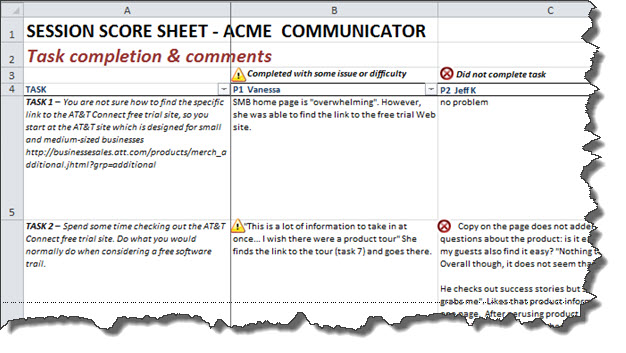Hello
I hope you are doing well! The theme of this month's Usability Tidbits is "to watch what they do and not listen to what they say" in a usability study. I hope you find this advice useful. Feel free to send your comments and questions to me at Kay@UsabilityResources.net.
Thanks for reading my newsletter,
Kay
***********************
Poorly designed technology makes people feel dumb and cranky |
The goal of a usability study is to put your product into the hands of a user and see what they do with it. Do they understand the nature of the product and its key features just by looking at it and touching it? Can they perform common tasks without a lot of frustration or cumbersome extra steps? What does their facial expression and body language communicate about how they feel as they use your product?
Usability testing is unique from other forms of qualitative research because a participant’s behavior matters more than their words.
Can they do their task without a lot of extra effort?
When running a usability, just watch the person work
Be silent - let the participant do all the talking. Otherwise you run the risk of giving them clues. Ask the person to talk out loud as they carry out each task because this will help you understand the logic behind their behavior and choices.
Keep track of the person’s task success and failure, why they failed and where they struggled. Be systematic about your data collection for each person who takes part in your study. Soon you’ll see patterns that clearly point to areas of your product that need redesign.
To present these results to your team, create a “scoreboard” of task success/failure for each participant by task. Everyone will be able to tell at a glance which aspects of the product design are working (or not working) for users. A scoreboard display also presents usability results in a succinct and objective way which lends credibility to your efforts.
|

Keep score of where they succeed and where they fail
|
|
Collect usability feedback separately from emotional feedback
There is plenty of room for learning participant’s emotional reactions, attitudes, perceptions, and opinions about your product and how it stacks up against the competition. Leave time at the end of a session to debrief with the person, to answer questions they have about the product, and clear up confusions.
The debrief discussion is also a good opportunity to probe deeper into the participant’s thought process and impressions, gather ideas for new features, and to administer surveys. You might also invite two or three members of the client team into the room so they can talk directly with participants and become part of the process.
Above all, don't worry about running a perfect usability study - it is more important to get out there and "Just do it"! You'll learn more than you can imagine on how to improve your product. Call us to help you get started.
Good luck and Happy Valentine's Day!
Kay
****************************************
Kay Corry Aubrey - Usability Consultant and Interface Designer
Usability Resources Inc , www.UsabilityResources.net
LinkedIn Profile, http://www.linkedin.com/in/kaycorryaubrey
Usability Resources Inc is SOWMBA/DBE certified
About Kay
Kay Corry Aubrey helps teams make their products more easily understandable to their targeted audiences. She does this through usability consulting and team mentorship. Kay is a recognized expert in qualitative research, usability testing, and user interface design. Kay started Usability Resources Inc in 2002 and since then has worked with organizations as diverse as Abt Associates, AT&T Mobility, iRobot, The Broad Institute, Columbia University Libraries, Constant Contact, NIH, Moxie Software, and the Mayo Clinic. Kay also teaches usability and design at Northeastern University.
To learn more about how Usability Resources Inc can help you, please visit www.UsabilityResources.net, or contact us directly at 781-275-3020,
|